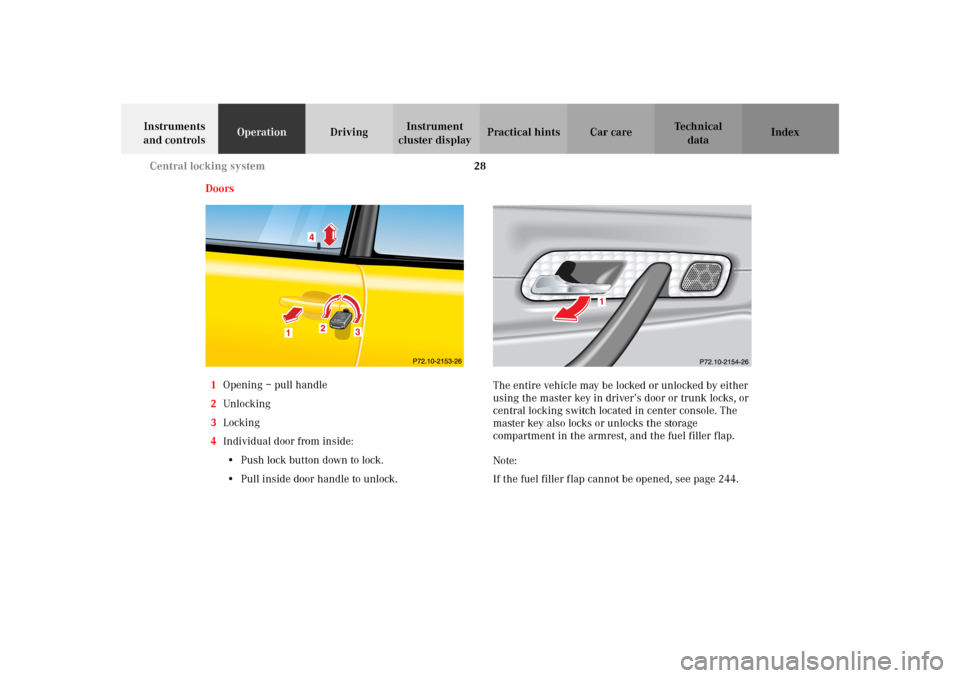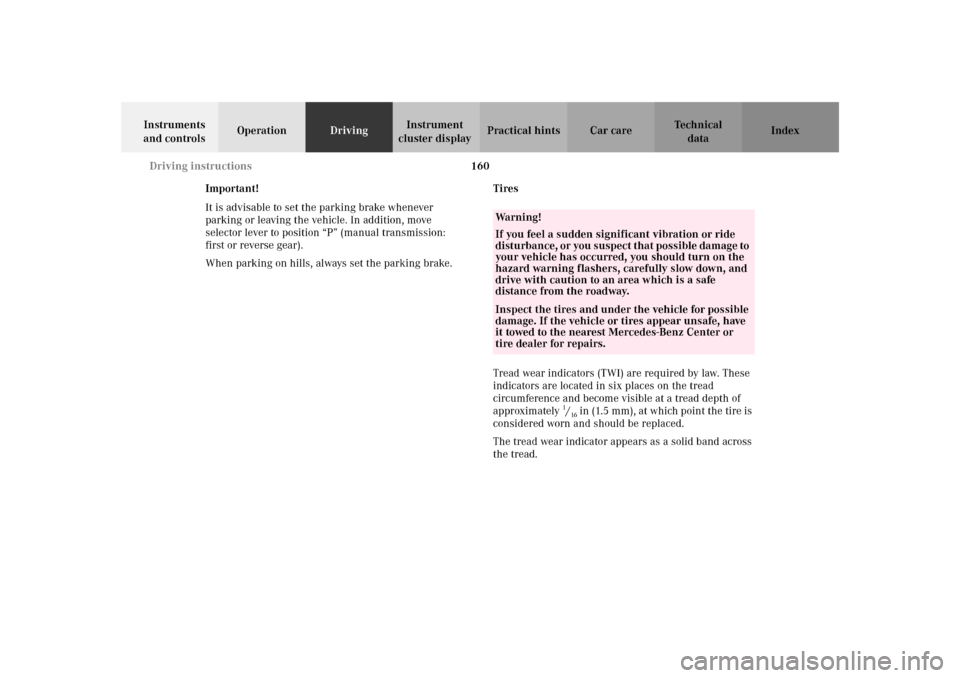2002 MERCEDES-BENZ SLK 230 KOMPRESSOR Tire
[x] Cancel search: TirePage 5 of 290

2 Contents
Interior lighting ............................. 112
Night security illumination ......... 112
Sun visors with Vanity Mirror ......113
Interior .............................................113
Cup holder and glove box ..............114
Storage compartments ...................115
Ashtrays ...........................................116
Coin Holder ......................................116
Lighter ..............................................117
Parcel net in passenger footwell ..118
Shelf behind roll bars .....................118
Cellular telephone ..........................118
Garage door opener ........................119
Retractable hardtop ....................... 122
Wind screen .................................... 127
Luggage cover ................................. 128
DrivingControl and operation of
radio transmitters ..................... 130
The first 1 000 miles
(1 500 km) ................................. 131
Maintenance ................................... 131Tele Aid ............................................132
Catalytic converter ........................ 140
Emission control ............................. 141
Steering lock .................................. 142
Starting and turning off
the engine .................................. 144
Manual transmission .................... 145
Automatic transmission ............... 147
Parking brake .................................156
Driving instructions .......................157
Drive sensibly – Save Fuel ........157
Drinking and driving .................157
Pedals ...........................................157
Power assistance .........................158
Brakes ...........................................158
Driving off ....................................159
Parking .........................................159
Tires ..............................................160
Snow chains ................................163
Winter driving instructions ......163
Block heater .................................165
Deep water ...................................165
Passenger compartment ............165
Traveling abroad .........................165Cruise control ................................. 166
Brake assist system
(BAS) ........................................... 169
Antilock brake system
(ABS) ........................................... 171
Electronic stability program
(ESP) ........................................... 173
What you should know
at the gas station ....................... 177
Check regularly and
before a long trip ...................... 179
Instrument cluster displayMalfunction and
indicator lamps in the
instrument cluster .................... 182
On-board diagnostic system ..... 182
Check engine malfunction
indicator lamp ............................. 182
Brake warning lamp .................. 183
Brake pad wear
indicator lamp ............................. 184
Seat belt nonusage
warning lamp .............................. 184
Page 6 of 290

3 ContentsSupplemental restraint system
(SRS) indicator lamp .................. 184
Fuel reserve and fuel cap
placement warning .................... 185
Electronic stability program
(ESP) — warning lamp ............... 185
BAS / ESP malfunction
indicator lamp ............................. 185
ABS malfunction
indicator lamp ............................. 186
Telescoping steering column
warning lamp .............................. 186
Low engine coolant level
warning lamp .............................. 187
Low windshield and headlamp
washer system fluid level
warning lamp .............................. 187
Low engine oil level
warning lamp .............................. 188
Charge indicator lamp ............... 188
Exterior lamp failure i
ndicator lamp .............................. 189
Additional function
indicator lamps
(in the odometer display) .......... 189Malfunction and indicator lamp
in the center console ................190
AIRBAG OFF indicator lamp .....190
Practical hintsFirst aid kit ......................................192
Stowing items in the vehicle ........192
Fuses ................................................192
Hood .................................................194
Automatic transmission
fluid level ....................................196
Checking engine oil level ..............197
Coolant level ....................................198
Adding coolant ............................198
Windshield and
headlamp washer system .........199
Air pump, spare wheel,
vehicle tools,
storage compartment
(except SLK 32 AMG) .............. 200
Ve h i c l e j a c k
(except SLK 32 AMG) .............. 201Storage box, TIREFIT-Kit,
air pump, Vehicle tools
(SLK 32 AMG only) ...................202
Wheels .............................................203
Tire replacement ........................203
Rotating wheels ..........................204
Spare wheel ....................................205
Spare wheel bolts .......................206
Changing wheels ...........................207
Inflating the collapsible
spare tire ..................................... 212
Storing spare wheel in
wheel well ................................... 213
TIREFIT ........................................... 214
Tire inflation pressure .................. 219
Battery .............................................220
Jump starting ..................................222
Towing the vehicle .........................224
Transmission selector lever,
manually unlocking ..................229
Exterior lamps ................................230
Headlamp assembly ................... 231
Taillamp assemblies ..................234
Page 31 of 290

28 Central locking system
Te ch n i c a l
data Instruments
and controlsOperationDrivingInstrument
cluster displayPractical hints Car care Index
Doors
1Opening – pull handle
2Unlocking
3Locking
4Individual door from inside:
•Push lock button down to lock.
•Pull inside door handle to unlock.The entire vehicle may be locked or unlocked by either
using the master key in driver’s door or trunk locks, or
central locking switch located in center console. The
master key also locks or unlocks the storage
compartment in the armrest, and the fuel filler flap.
Note:
If the fuel filler flap cannot be opened, see page 244.
Page 59 of 290

56 Restraint systems
Te ch n i c a l
data Instruments
and controlsOperationDrivingInstrument
cluster displayPractical hints Car care Index
The following system components are monitored or
undergo a selfcheck: crash-sensor(s), airbag ignition
circuits, seat belt buckles, emergency tensioning
retractors, seat sensor.
Initially, when the key is turned from steering lock
position 0 to positions 1 or 2, malfunctions in the crash-
sensor are detected and indicated (the “SRS” indicator
lamp stays on longer than 4 seconds or does not come
on). In the operational mode, after the indicator lamp
has gone out following the initial check, interruptions or
short circuits in the airbag ignition circuit and in the
driver and passenger seat belt buckle harnesses, and
low voltage in the entire system are detected and
indicated.
Have the system checked at your authorized
Mercedes-Benz Center immediately.
Wa r n i n g !
In the event a malfunction of the “SRS” is indicated
as outlined above, the “SRS” may not be
operational. For your safety, we strongly
recommend that you visit an authorized Mercedes-
Benz Center immediately to have the system
checked; otherwise the “SRS” may not be activated
when needed in an accident, which could result in
serious or fatal injury, or it might deploy
unexpectedly and unnecessary which could also
result in injury.
Page 132 of 290

129 Contents - Driving
Te ch n i c a l
data Instruments
and controlsOperationDrivingInstrument
cluster displayPractical hints Car care Index
DrivingControl and operation of
radio transmitters ..................... 130
The first 1 000 miles
(1 500 km) ................................. 131
Maintenance ................................... 131
Tele Aid ........................................... 132
Catalytic converter ........................ 140
Emission control ............................ 141
Steering lock ................................... 142
Starting and turning off
the engine .................................. 144
Manual transmission .................... 145
Automatic transmission ............... 147
Parking brake ................................. 156Driving instructions .......................157
Drive sensibly – Save Fuel ........157
Drinking and driving .................157
Pedals ...........................................157
Power assistance .........................158
Brakes ...........................................158
Driving off ....................................159
Parking .........................................159
Tires ..............................................160
Snow chains ................................163
Winter driving instructions ......163
Block heater .................................165
Deep water ...................................165
Passenger compartment ............165
Traveling abroad .........................165Cruise control ................................. 166
Brake assist system
(BAS) ........................................... 169
Antilock brake system
(ABS) ........................................... 171
Electronic stability program
(ESP) ........................................... 173
What you should know
at the gas station ....................... 177
Check regularly and
before a long trip ...................... 179
Page 138 of 290

135 Tele Aid
Te ch n i c a l
data Instruments
and controlsOperationDrivingInstrument
cluster displayPractical hints Car care Index Roadside Assistance button •
Located below the center armrest cover is the Roadside
Assistance button•. Pressing and holding the
button (for longer than 2 seconds), will initiate a call to
a Mercedes-Benz Roadside Assistance dispatcher. The
button will flash while the call is in progress. The
Tele Aid system will transmit data generating the
vehicle identification number, model, color and location
(subject to availability of cellular and GPS signals).
A voice connection between the Roadside Assistance
dispatcher and the occupants of the vehicle will be
established. The nature of the need for assistance can
then be described. The Mercedes-Benz Roadside assistance dispatcher will
either dispatch a qualified Mercedes-Benz technician or
arrange to tow your vehicle to the nearest
Mercedes-Benz Center. For services such as labor and/
or towing charges may apply. Refer to the Roadside
Assistance manual for more information.
These programs are only available in the USA:
•Sign and Drive services: Services such as jump start,
a few gallons of fuel or the replacement of a flat tire
with the vehicle spare tire are obtainable,
•Remote Vehicle Diagnostics: This function permits
the Mercedes-Benz Roadside Assistance dispatcher
to download malfunction codes and actual vehicle
data.
Notes:
The indicator lamp in the Roadside Assistance
button• remains illuminated in red for
approximately 10 seconds during the system self-check
after turning key in steering lock to position 2 (together
with the “SOS” button and the Information
button¡).
Wa r n i n g !
If you feel at any way in jeopardy when in the
vehicle (e.g. smoke or fire in the vehicle, vehicle in
a dangerous road location), please do not wait for
voice contact after you have pressed the emergency
button. Carefully leave the vehicle and move to a
safe location. The Response Center will
automatically contact local emergency officials
with the vehicle’s approximate location if they
receive an automatic “SOS” signal and cannot make
voice contact with the vehicle occupants.
Page 160 of 290

157 Driving instructions
Te ch n i c a l
data Instruments
and controlsOperationDrivingInstrument
cluster displayPractical hints Car care Index Driving instructions
Drive sensibly – Save Fuel
Fuel consumption, to a great extent, depends on driving
habits and operating conditions.
To save fuel you should:
•keep tires at the recommended inflation pressures,
•remove unnecessary loads,
•allow engine to warm up under low load use,
•avoid frequent acceleration and deceleration,
•have all maintenance work performed at regular
intervals by an authorized Mercedes-Benz Center.
Fuel consumption is also increased by driving in cold
weather, in stop-and-go traffic, on short trips and in hilly
country.Drinking and driving
Ped al s
Wa r n i n g !
Drinking or taking drugs and driving can be a very
dangerous combination. Even a small amount of
alcohol or drugs can affect your reflexes,
perceptions and judgement.The possibility of a serious or even fatal accident is
sharply increased when you drink or take drugs
and drive.Please don‘t drink or take drugs and drive or allow
anyone to drive after drinking or taking drugs.Wa r n i n g !
Keep driver‘s foot area clear at all times. Objects
stored in this area may impair pedal movement.
Page 163 of 290

160 Driving instructions
Te ch n i c a l
data Instruments
and controlsOperationDrivingInstrument
cluster displayPractical hints Car care Index
Important!
It is advisable to set the parking brake whenever
parking or leaving the vehicle. In addition, move
selector lever to position “P” (manual transmission:
first or reverse gear).
When parking on hills, always set the parking brake.Tires
Tread wear indicators (TWI) are required by law. These
indicators are located in six places on the tread
circumference and become visible at a tread depth of
approximately
1/16 in (1.5 mm), at which point the tire is
considered worn and should be replaced.
The tread wear indicator appears as a solid band across
the tread.
Wa r n i n g !
If you feel a sudden significant vibration or ride
disturbance, or you suspect that possible damage to
your vehicle has occurred, you should turn on the
hazard warning flashers, carefully slow down, and
drive with caution to an area which is a safe
distance from the roadway.Inspect the tires and under the vehicle for possible
damage. If the vehicle or tires appear unsafe, have
it towed to the nearest Mercedes-Benz Center or
tire dealer for repairs.